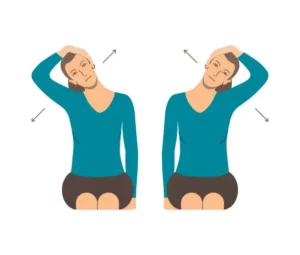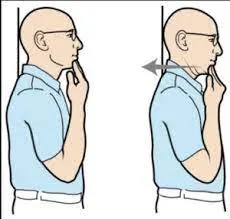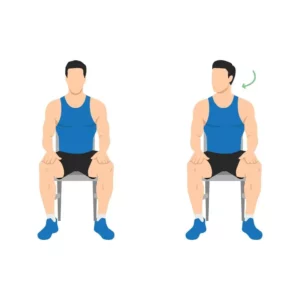The simple act of looking up, whether to admire a starry night or to reach for a book on a high shelf, should be pain-free. Yet for many, this upward gaze is marred by an unexpected twinge, a sharp ache in the neck. If this sounds familiar, you’re not alone. Countless individuals wrestle with this discomfort daily, often unsure of its cause or how to address it. But what if the solution was within reach? If you’re tired of being held back by neck pain when looking up, you’re in the right place. Dive in as we unpack the root causes of this ailment and offer easy, actionable exercises and treatments to reclaim your pain-free gaze.
Contents
Why Does Looking Up Cause Neck Pain?
 To understand why looking up can cause neck pain, let’s delve into the anatomy and common culprits behind this pain:
To understand why looking up can cause neck pain, let’s delve into the anatomy and common culprits behind this pain:
- Cervical Spine Anatomy: The neck, medically known as the cervical spine, comprises seven vertebrae, starting from the base of the skull and extending to the upper torso. Between these vertebrae lie discs, acting as cushions, while muscles and ligaments provide support and enable movement.
- Muscle Strain: Just like any other muscle in our body, the neck muscles can be overstrained. Continually looking upwards, especially without proper support, can stretch these muscles beyond their comfort zone, leading to microscopic tears and, consequently, pain.
- Disc Issues: The discs in our cervical spine can deteriorate or get injured. When this happens, it might press on the nearby nerve, causing pain especially when the neck is tilted backward or looking up. Conditions like herniated discs or cervical spondylosis can be behind this.
- Postural Habits: In today’s digital age, many of us are guilty of the ‘tech-neck’ – the forward and downward tilt of our heads while using devices. This habit strains the neck muscles over time. When we then try to look up, these already strained muscles are further stretched, causing discomfort.
- Degenerative Conditions: Age-related conditions like osteoarthritis can cause the wear and tear of the protective cartilage, leading to bone spurs or a reduced space for the spinal cord and nerves. These conditions can make movements like looking up painful.
- Previous Injuries: Past traumas or injuries, like whiplash from a car accident, can leave behind lingering vulnerabilities in the neck region. As a result, movements outside the usual range, such as looking up, might trigger pain.
- Facet Joint Dysfunction: The facet joints in the cervical spine allow for flexibility. When these joints become inflamed or injured, it can cause pain during extension or when tilting the head backward.
Recognizing the root cause is the first step to addressing the issue. Whether it’s a simple muscle strain or something more complex like a disc problem, understanding the ‘why’ behind the pain can guide more effective solutions.
Simple Stretches for Immediate Relief
While the intricate structure of the neck provides a vast range of motion, it’s also vulnerable to tension and discomfort. Luckily, with the right stretches, you can provide your neck with much-needed relief. Below are some straightforward, easy-to-follow exercises designed to ease tension.
Neck Tilt Stretch

- How to do it: Sit or stand with a straight spine. Slowly tilt your head to one side, aiming to touch the ear to the shoulder. Hold for 15-20 seconds, then repeat on the other side.
- Benefits: This stretch targets the side muscles of the neck, relieving tension and tightness.
Forward Neck Stretch

- How to do it: Begin in a seated or standing position. Gently tilt your head forward, bringing the chin toward the chest. Hold the stretch for 15-20 seconds.
- Benefits: This movement stretches the back of the neck and can help counteract the effects of prolonged forward neck postures.
Neck Turn Stretch

- How to do it: With a straight back, slowly turn your head to one side until you feel a stretch along the side of the neck and the top of the shoulder. Hold for 15-20 seconds and switch sides.
- Benefits: This helps improve neck flexibility and relieves tension along the sides.
Neck Extension Stretch

- How to do it: Sit comfortably. Carefully tilt your head back, gazing upwards, until you feel a stretch along the front of the neck. Hold for 15-20 seconds.
- Benefits: This can be especially beneficial if your pain arises from looking up, as it stretches and strengthens the front neck muscles.
Levator Scapula Stretch
- How to do it: Sit on a chair with one hand placed under your thigh to anchor it. Turn your head 45 degrees to the opposite side and then tilt it downward, aiming your chin towards your armpit. You should feel a stretch on the back/side of your neck. Hold for 15-20 seconds, then repeat on the other side.
- Benefits: This targets the levator scapulae muscle, often responsible for a lot of neck tension.
While these stretches can offer immediate relief, it’s crucial to integrate them into a daily routine for long-lasting results. Additionally, if any stretch causes pain or exacerbates existing discomfort, it’s wise to stop and consult with a healthcare professional. Remember, stretching should bring relief, not pain.
Strengthening Exercises for Long-Term Comfort
While stretches can provide immediate relief, the key to long-term comfort and preventing recurrent neck pain lies in strengthening. By fortifying the muscles supporting the neck and upper back, you not only build resistance against strains but also promote better posture, reducing vulnerability to injuries. Here’s a set of exercises aimed at strengthening these critical areas.
Chin Tucks
How to do it: Sit or stand with a straight spine. Slowly tuck your chin to your chest, creating a double chin. Hold for 5 seconds, then release. Repeat 10 times.
Isometric Neck Exercises
How to do it: Using your hand, apply gentle pressure to your head. Push your head against your hand without letting your head move. Do this in all four directions: forward, backward, left, and right. Hold each push for 5 seconds.
Shoulder Blade Squeeze
How to do it: Sit or stand tall. Pull your shoulder blades down and back, trying to squeeze them together. Hold for 5 seconds and then release. Repeat 10 times.
Wall Angels
How to do it: Stand with your back against a wall, with elbows and wrists touching the wall. Slide your arms up and down (like making a snow angel). Ensure your back and arms remain in contact with the wall throughout.
Neck Bridge
How to do it: Lie on your back with knees bent. Lift your head off the ground slightly and push your neck into the ground, using it as a pivot to lift your chest upwards. Hold for a few seconds, then lower. Repeat 5 times.
Resistance Band Pull Apart
How to do it: Hold a resistance band with both hands in front of you, arms extended. Keeping your arms straight, pull the band apart by squeezing your shoulder blades together. Slowly return to the starting position and repeat.
For achieving long-term comfort, consistency is the key. Make these exercises a routine, and over time, not only will your neck become more resilient to strains, but your overall posture will improve, further diminishing the chances of future discomfort.
Ergonomic Adjustments for Daily Activities
Here are some essential ergonomic adjustments in your daily life that can have a profound impact on your neck health:
- Workspace Set-Up:
- Monitor Position: Ensure your computer monitor is at eye level. If it’s too low, you’ll be tempted to lean forward or look down, straining your neck.
- Chair Support: Invest in a chair with good neck and lumbar support. Your feet should be flat on the ground, and your knees at a 90-degree angle.
- Keyboard and Mouse: These should be at a height that allows your elbows to be at a 90-degree angle or slightly obtuse, preventing you from raising your shoulders or reaching forward.
- Smartphone Usage:
- Raise Your Phone: Instead of constantly looking down at your phone, raise it to eye level. This will prevent the “tech-neck” posture that strains the cervical spine.
- Take Breaks: Every few minutes, look up from your screen and stretch your neck. It prevents prolonged strain.
- Sleeping Habits:
- Pillow Position: Use a pillow that supports the natural curve of your neck. Too high or too low pillows can cause misalignment.
- Sleeping Position: Try to sleep on your back or side. Stomach sleeping can twist the neck and spine.
- Driving Ergonomics:
- Headrest Position: Adjust your headrest so that the middle of your head touches it. It not only supports the neck but can also prevent whiplash in case of an accident.
- Steering Wheel Grip: Keep your hands at the 9 o’clock and 3 o’clock positions to avoid raising your shoulders and stressing your neck.
- Daily Activities:
- Eye-Level Shelving: For items you use frequently, try to store them at eye level so you don’t have to constantly reach up or bend down.
- Carrying Loads: Use a backpack rather than a one-shoulder bag. When carrying heavy items, keep them close to your body.
- Exercise Posture:
- Form First: Whether you’re lifting weights, doing yoga, or any exercise, maintaining proper form is essential. Poor form during physical activity can quickly lead to neck strain or injury.
By incorporating these small tweaks into your daily activities, you can significantly reduce the strain on your neck.
Knowing When to Seek Professional Help
While minor neck pain, especially when looking up, might be a temporary issue resolved with stretches and ergonomic adjustments, it’s crucial to recognize when professional intervention becomes necessary.
If your neck pain persists for more than a week despite home remedies, or if it seems to be getting worse, it’s time to consult a professional. Continuous discomfort could be indicative of a more severe underlying issue.
Pain that radiates down to the shoulders, arms, or fingers, or is accompanied by tingling or numbness, may signify nerve compression.
If your neck pain is accompanied by other symptoms like severe headaches, dizziness, nausea, or visual disturbances, it could be a sign of a more serious condition that needs prompt evaluation.
Therapeutic Options Available: Professional treatments for neck pain are varied, catering to the specific cause and severity of the discomfort.
- Physical Therapy: This involves guided exercises and techniques to strengthen the neck muscles, improve posture, and restore the range of motion.
- Chiropractic Care: Chiropractors specialize in spinal adjustments which can be beneficial for those with alignment issues causing their neck pain.
- Massage Therapy: Targeted massage can help alleviate muscle tension, promote circulation, and provide relief from chronic pain.
- Medications: Over-the-counter pain relievers or prescribed medications can help manage pain. Some professionals might also recommend muscle relaxants or anti-inflammatory drugs.
- Injections: In cases of severe pain, professionals might suggest corticosteroid injections or nerve block therapies to target specific pain sources.
Conclusion
The delicate intricacies of our neck demand attention and care. From simple ergonomic adjustments to specific exercises, there’s much we can do to alleviate discomfort and promote neck health. Yet, in the face of persistent pain or concerning symptoms, it’s essential to reach out for professional guidance. Remember, timely intervention can prevent complications and ensure you’re on the quickest path to recovery. If you’re experiencing Neck pain, physical therapy for neck pain at PhysioMantra can help: Book an online physical therapy session.



